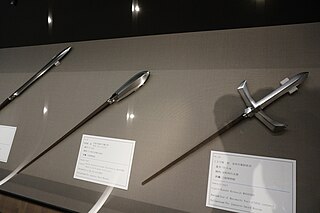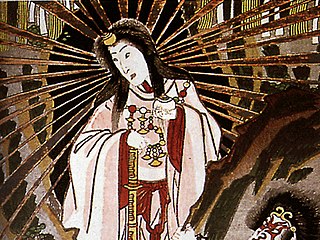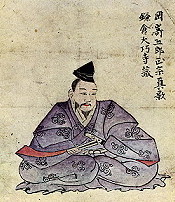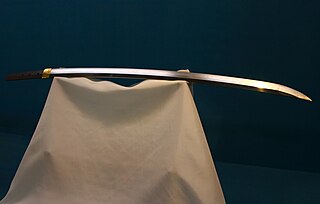Related Research Articles

A Japanese sword is one of several types of traditionally made swords from Japan. Bronze swords were made as early as the Yayoi period, though most people generally refer to the curved blades made from the Heian period (794–1185) to the present day when speaking of "Japanese swords". There are many types of Japanese swords that differ by size, shape, field of application and method of manufacture. Some of the more commonly known types of Japanese swords are the uchigatana, tachi, ōdachi, wakizashi, and tantō.
A tachi is a type of sabre-like traditionally made Japanese sword (nihonto) worn by the samurai class of feudal Japan. Tachi and uchigatana generally differ in length, degree of curvature, and how they were worn when sheathed, the latter depending on the location of the mei (銘), or signature, on the tang. The tachi style of swords preceded the development of the katana, which was not mentioned by name until near the end of the twelfth century. Tachi were the mainstream Japanese swords of the Kotō period between 900 and 1596. Even after the Muromachi period (1336–1573), when katana became the mainstream, tachi were often worn by high-ranking samurai.

Yari (槍) is the term for a traditionally-made Japanese blade in the form of a spear, or more specifically, the straight-headed spear. The martial art of wielding the yari is called sōjutsu.

Kusanagi-no-Tsurugi is a legendary Japanese sword and one of three Imperial Regalia of Japan. It was originally called Ame-no-Murakumo-no-Tsurugi, but its name was later changed to the more popular Kusanagi-no-Tsurugi. In folklore, the sword represents the virtue of valor.

A tantō is one of the traditionally made Japanese swords that were worn by the samurai class of feudal Japan. The tantō dates to the Heian period, when it was mainly used as a weapon but evolved in design over the years to become more ornate. Tantō were used in traditional martial arts. The term has seen a resurgence in the West since the 1980s as a point style of modern tactical knives, designed for piercing or stabbing.

Gorō Nyūdō Masamune was a medieval Japanese blacksmith widely acclaimed as Japan's greatest swordsmith. He created swords and daggers, known in Japanese as tachi and tantō, in the Sōshū school. However, many of his forged tachi were made into katana by cutting the tang (nakago) in later times ("suriage"). For this reason, his only existing works are katana, tantō, and wakizashi. No exact dates are known for Masamune's life. It is generally agreed that he made most of his swords between 1288 and 1328. Some stories list his family name as Okazaki, but some experts believe this is a fabrication to enhance the standing of the Tokugawa family.
Muramasa, commonly known as Sengo Muramasa (千子村正), was a famous swordsmith who founded the Muramasa school and lived during the Muromachi period in Kuwana, Ise Province, Japan.

The ōdachi (大太刀) or nodachi is a type of traditionally made Japanese sword used by the samurai class of feudal Japan. The Chinese equivalent of this type of sword in terms of weight and length is the miaodao or the earlier zhanmadao, and the Western battlefield equivalent is the Zweihänder.
Dōtanuki (同田貫) is a name of a Japanese school of swordsmiths from Higo province who produced swords in the Bizen tradition during the feudal period of Japan.

In mythology, legend or fiction, a magic sword is a sword with magical powers or other supernatural qualities. Renowned swords appear in the folklore of every nation that used swords.

Minamoto no Yoshiie, also known as Hachimantarō (八幡太郎) and his title Most Valorous Warrior in the Land (天下第一武勇之士), was a Minamoto clan samurai of the late Heian period, and Chinjufu-shōgun.

Japanese sword mountings are the various housings and associated fittings that hold the blade of a Japanese sword when it is being worn or stored. Koshirae (拵え) refers to the ornate mountings of a Japanese sword used when the sword blade is being worn by its owner, whereas the shirasaya is a plain undecorated wooden mounting composed of a saya and tsuka that the sword blade is stored in when not being used.

Bladesmithing is the art of making knives, swords, daggers and other blades using a forge, hammer, anvil, and other smithing tools. Bladesmiths employ a variety of metalworking techniques similar to those used by blacksmiths, as well as woodworking for knife and sword handles, and often leatherworking for sheaths. Bladesmithing is an art that is thousands of years old and found in cultures as diverse as China, Japan, India, Germany, Korea, the Middle East, Spain and the British Isles. As with any art shrouded in history, there are myths and misconceptions about the process. While traditionally bladesmithing referred to the manufacture of any blade by any means, the majority of contemporary craftsmen referred to as bladesmiths are those who primarily manufacture blades by means of using a forge to shape the blade as opposed to knifemakers who form blades by use of the stock removal method, although there is some overlap between both crafts.

In swordsmithing, hamon (刃文) is a visible effect created on the blade by the hardening process. The hamon is the outline of the hardened zone which contains the cutting edge. Blades made in this manner are known as differentially hardened, with a harder cutting edge than spine. This difference in hardness results from clay being applied on the blade prior to the cooling process (quenching). Less or no clay allows the edge to cool faster, making it harder but more brittle, while more clay allows the center and spine to cool slower, thus retaining its resilience.

Japanese swordsmithing is the labour-intensive bladesmithing process developed in Japan beginning in the sixth century for forging traditionally made bladed weapons (nihonto) including katana, wakizashi, tantō, yari, naginata, nagamaki, tachi, nodachi, ōdachi, kodachi, and ya (arrow).

A katana is a Japanese sword characterized by a curved, single-edged blade with a circular or squared guard and long grip to accommodate two hands. Developed later than the tachi, it was used by samurai in feudal Japan and worn with the edge facing upward. Since the Muromachi period, many old tachi were cut from the root and shortened, and the blade at the root was crushed and converted into a katana. The specific term for katana in Japan is uchigatana (打刀) and the term katana (刀) often refers to single-edged swords from around the world.

Legendary weapons, arms, and armor are important motifs in Chinese mythology as well as Chinese legend, cultural symbology, and fiction. Weapons featured in Chinese mythology, legend, cultural symbology, and fiction include Guanyu's pole weapon. This non-factually documented weapon has been known as the Green Dragon Crescent Blade. Other weapons from Chinese mythology, legend, cultural symbology, and fiction include the shield and battleax of the defiant dancer Xingtian, Yi's bow and arrows, given him by Di Jun, and the many weapons and armor of Chiyou, who is associated with the elemental power of metal. Chinese mythology, legend, cultural symbology, and fiction features the use of elemental weapons such as ones evoking the powers of wind and rain to influence battle.
References
- ↑ Yumoto, John M. (2002). The Samurai Sword: A Handbook. Tittle Publishing.
- ↑ "A brief overview of Samurai Sword History". Sword-buyers-guide.com. 2013-05-27. Retrieved 2013-05-31.
- ↑ "The Beauty of the Sword" (PDF). Meitokukan. Archived from the original (PDF) on 2014-01-09. Retrieved 2013-05-31.
- ↑ "Legends of the Samurai". Winston-Salem/Forsyth County Schools. Archived from the original on 2016-03-04.